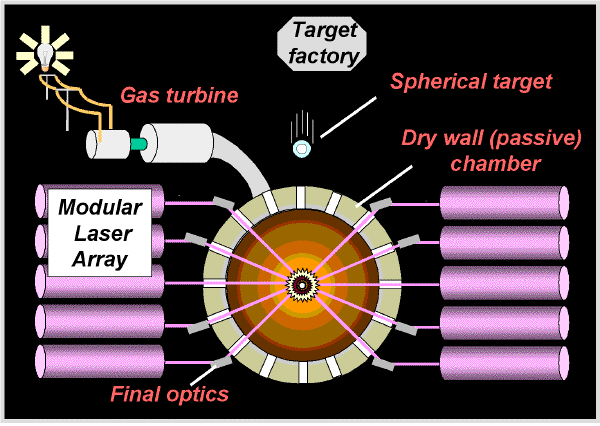| The High Average Power Laser Program was a coordinated, focussed multi-lab effort to develop the science and technology for a Laser Inertial Fusion Energy (Laser IFE). The program was established by scientists at national labs, universities and industry.1 Fusion is the power source of the sun. It is the energy released when two isotopes of hydrogen are combined, or "fused", to produce a heavier atom (helium) and energy. If fusion could be harnessed on Earth, the power plant would have unlimited fuel (the ingredients are deuterium, a hydrogen isotope, and lithium, a plentiful element), no chemical by-products, and no long-term radioactive waste. The payoffs are so large that numerous scientific institution world-wide have been working on this problem. However after almost 50 years the solution is still elusive and challenging. In the approach we are pursuing, an array of intense lasers symmetrically and directly illuminates a cryogenic target that has been injected into the chamber. The target is compressed and heated to undergo thermonuclear burn. The energy released by the target is recovered by the chamber wall and converted into electricity. A schematic appears below: |
 |
| 1Participants in this program were: DoD/DoE Labs: Naval Research Laboratory, Lawrence Livermore National Laboratory, Sandia National Laboratory, Los Alamos National Laboratory, Oak Ridge National Lab, Princeton Plasma Physics Laboratory, Argonne National Laboratory, and Idaho National Engineering Laboratory Industry: General Atomics, Titan-Pulse Sciences Division, Schafer Corp, Science Applications International Corp, Northrop-Grumman, Coherence, Inc. Commonwealth Technology, Inc. University: University of California, San Diego, University of Wisconsin, University of California, Los Angeles, and University of Rochester Laboratory for Laser Energetics |
|
The attractiveness of this approach lies in its inherent simplicity, its separable architecture, and the modular nature of the laser driver. The targets are spherical shells. In principal, they can be fabricated in a single droplet generator and thus naturally lend themselves to automated, low cost, production. There is no hohlraum debris to recycle. The first wall is a passive structure that does not have to hold vacuum. Thus it can be made in individual sectors that can be replaced during the plant lifetime. Not having to worry about vacuum integrity allows more choices for the first wall, such as advanced composites or two-component structures. The separable nature of the power plant significantly lowers development costs (the components can be fully developed separately before being integrated into the system), and just as importantly, allows economical upgrades as new technologies are developed. The modular laser would consist of a number (20-40) of identical parallel beam lines. Hence it is only necessary to develop one of these lines to develop the entire system. This also significantly reduces development costs. While there are many science and engineering challenges that must be met to realize this concept, there have already been sufficient advances in target design, target experiments, lasers, and associated technologies to make this a promising viable energy source: High gain target designs are under development that promise sufficient gain (120-400) for a fusion power plant. Two laser concepts have been identified: Krypton fluoride lasers (KrF), under development at NRL, and diode pumped solid-state lasers (DPSSL) under development at LLNL. Both have the potential to meet the fusion energy requirements for efficiency, durability and cost. Power plant studies have shown that this can be an economically attractive approach. We believe the concept looks sufficiently attractive that we have forged a phased, relatively fast-paced program to evaluate the major uncertainties. In 1999 and 2000 the program concentrated on the two laser concepts. Since 2001 the program has expanded to address all the critical components in Laser IFE, including target fabrication, target injection, final optics, and fusion chamber research.
The Laser IFE Program follows four key overarching principles:
|